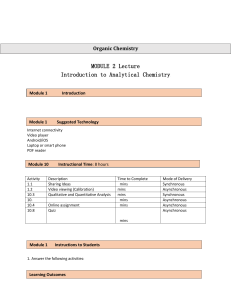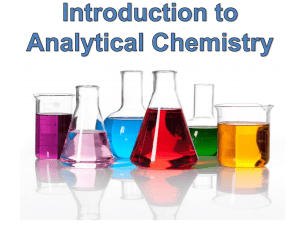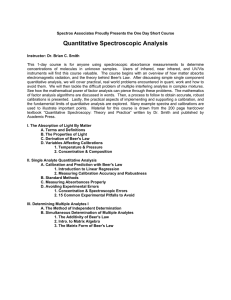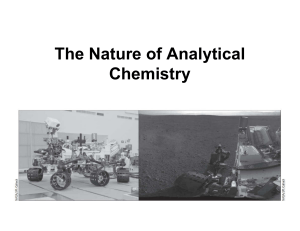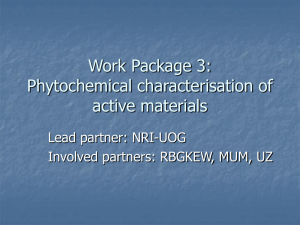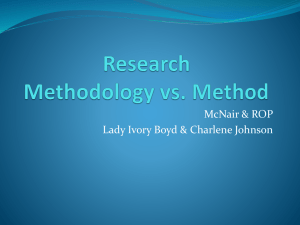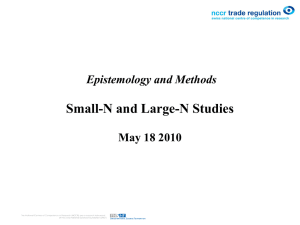Analytical chemistry
advertisement
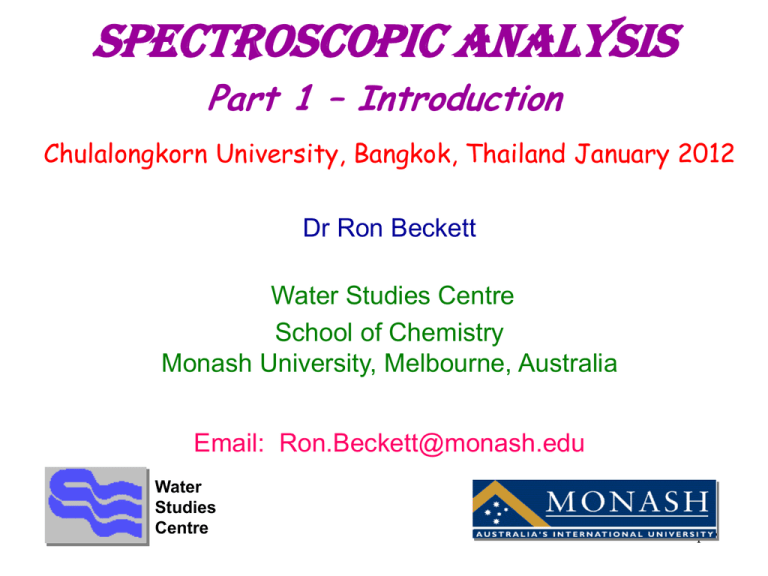
Spectroscopic Analysis Part 1 – Introduction Chulalongkorn University, Bangkok, Thailand January 2012 Dr Ron Beckett Water Studies Centre School of Chemistry Monash University, Melbourne, Australia Email: Ron.Beckett@monash.edu Water Studies Centre 1 Course Objectives • To gain a qualitative understanding of: the scope and methodology of Analytical Chemistry, EMR, specified spectroscopic experiments and analysis methods • Be able to perform certain calculations related to EMR and calibration of spectroscopic analyses • The examinable material will be defined by the handout notes and problems performed in class (NOT the Skoog et al. textbook, Chapters 1, 24-28, which should be used as reference material to assist in your understanding) 2 Assessment Scheme • 75% for a 2 hour exam based on the lecture notes and problems done in class • 10% for ONE homework assignment and general contribution to discussions in class • 15% for THREE tests done in class • Attendance: 1 mark deducted for each absence or late appearance in any class session without acceptable reason. Advise lecturer in advance of expected absence 3 Analytical Chemistry Analytical chemists perform two main tasks: 1. Qualitative Analysis identifies the elements and compounds present in a sample 2. Quantitative Analysis determines the relative amounts of these components 4 Importance of Analytical Chemistry Analytical chemistry is used to collect necessary data to solve problems in many fields of science such as: Chemistry, Biology, Environmental Studies, Agriculture, Medicine, Materials Science, Archeology, Forensic Science, Geology, Physics, Engineering, etc (see Figure 1.1 on page 5 of textbook) 5 Methods of Chemical Analysis • To estimate the concentration of an analyte may require both measurement of the mass or volume of the sample and some physical quantity that is related to the concentration of the element or compound. • This quantity can be classified as: 1. Gravimetric – mass of a precipitate 2. Volumetric – volume of a titration 3. Electroanalytical – voltage, current, amount of charge 4. Spectroscopic – absorbance, fluorescence, emission 5. Miscellaneous – radioactivity, reaction rate, refractive index 6 Steps in Quantitative Analysis 1. Choosing a Method • What is the concentration range (detection limit) • What accuracy is required (depends on the problem) • What elements or compounds are involved • How complex is the mixture (selectivity, separation) • How many samples are involved (analysis time) • What methods are available to you !!! 7 Steps in Quantitative Analysis 2. Obtaining the Sample • Golden Rule – an accurate chemicial analysis may be rendered useless if the sample analysed does not have the average composition of the whole batch • How would you collect a representative 1 g sample from a 10 tonne truck load of rock containing a small amount of the precious metal silver, given the particle size varies from 0.1 mm to 10 mm ? (2 m x 2 m x 1 m) 8 Steps in Quantitative Analysis 2. Obtaining the Sample • Replicate Samples – how many samples are required and where, when and how are they to be collected? • How would you collect a water sample in order to estimate the annual load of copper (tonnes of Cu per year) being transported down the Chaopraya River in Bangkok. Note both the water flow rate and the copper concentration must be measured. 9 Steps in Quantitative Analysis 3. Processing the Sample • Preparing and Storing Samples – SOLIDS - grinding, mixing, storage to avoid changes (water content, oxidation). Selecting the subsamples for analysis LIQUIDS – solvent & analyte evaporation, settling of solids, storage to minimise chemical changes (refrigeration, freezing, deoxygenate, dark) • Preparing Solutions – how to dissolve the sample (acid, base, oxidant, reductant, organic solvent)? 10 Steps in Quantitative Analysis 4. Eliminating Interferences • Impurities may contribute to (or decrease) the spectroscopic signal used to calculate the concentration e.g. Si produces the same blue colour as PO43- with molybdenate reagent • These interferences must be identified and their effect eliminated which can present a difficult problem. 11 Steps in Quantitative Analysis 5. Callibration • Accurate standards are usually used to plot a calibration line e.g. Absorbance vs Concentration A4 A3 Ax A=elc A2 A1 See Fig 1F-2 on Page 15 of Text A0 C0 C 1 C 2 C 3 Cx C 4 Concentration 12 Steps in Quantitative Analysis 5. Callibration • Straight line calibration graphs are preferred but may not be always possible • Standard compounds used to make the calibration solutions must be chemically stable e.g. metals should not oxidise, salts should not gain or lose water 13 Steps in Quantitative Analysis 6. Calculating Results and Estimating Reliability • Concentration of unknown samples is calculated using the calibration line equation • Precision is estimated using the standard deviation or standard error using replicate measurements • Accuracy is best evaluated by including some verified standard materials close in nature and composition to the unknown samples The checking of precision and accuracy is very important in analytical chemistry and is referred to 14 as quality control or quality assurance
